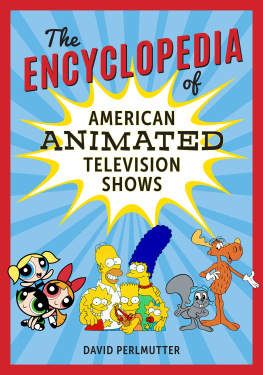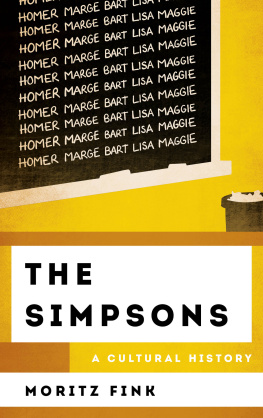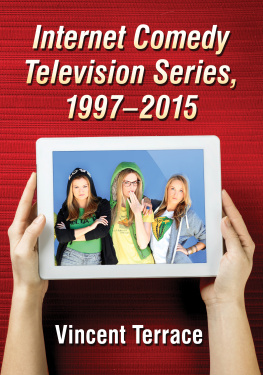The Encyclopedia of American Animated Television Shows
The Encyclopedia of American Animated Television Shows
David Perlmutter
Rowman & Littlefield
Lanham Boulder New York London
Published by Rowman & Littlefield
An imprint of The Rowman & Littlefield Publishing Group, Inc.
4501 Forbes Boulevard, Suite 200, Lanham, Maryland 20706
www.rowman.com
Unit A, Whitacre Mews, 26-34 Stannary Street, London SE11 4AB
Copyright 2018 by The Rowman & Littlefield Publishing Group, Inc.
All rights reserved. No part of this book may be reproduced in any form or by any electronic or mechanical means, including information storage and retrieval systems, without written permission from the publisher, except by a reviewer who may quote passages in a review.
British Library Cataloguing in Publication Information Available
Library of Congress Cataloging-in-Publication Data
Names: Perlmutter, David, 1980 author.
Title: The Encyclopedia of American animated television shows / David Perlmutter.
Description: Lanham : Rowman & Littlefield, 2018. | Includes bibliographical references and index.
Identifiers: LCCN 2017053633 (print) | LCCN 2017059743 (ebook) | ISBN 9781538103746 (electronic) | ISBN 9781538103739 (cloth : alk. paper)
Subjects: LCSH: Animated television programsUnited StatesEncyclopedias.
Classification: LCC PN1992.8.A59 (ebook) | LCC PN1992.8.A59 P48 2018 (print) | DDC 791.45/3dc23
LC record available at https://lccn.loc.gov/2017053633
 The paper used in this publication meets the minimum requirements of American National Standard for Information SciencesPermanence of Paper for Printed Library Materials, ANSI/NISO Z39.48-1992.
The paper used in this publication meets the minimum requirements of American National Standard for Information SciencesPermanence of Paper for Printed Library Materials, ANSI/NISO Z39.48-1992.
Printed in the United States of America
To the memory of June Foray (19182017), who, both directly through her work as a voice actor and indirectly as an influential off-screen figure, played a major and fundamental role in the shaping of American television animation as an institution.
Preface
Before we begin, it is important to establish at the outset what this encyclopedia consists of and also what it does not consist of so that you may have a pleasant journey looking through it, as is my intention. This encyclopedia consists of the following:
- All animated television programs that have aired on a television network or a cable television channel in the United States and Canada between the fall of 1948 and the spring of 2016, for which documented evidence exists for their existence in the form of primary (e.g., program content viewing, TV schedules and promotions, DVD issues, Internet redistribution) or secondary (e.g., print and online scholarship) research by myself and others. The programs featured in the book are those in which animation is the sole or majority content and for which animation is the central or only means by which the story is told. The one exception is Hanna-Barberas Ruff and Reddy , as discussed in the introduction, and this is done only to highlight its historical importance.
- The emphasis is on programs that aired in both the United States and Canada because most of the American series have aired in both countries, whereas not all of the Canadian series have. Canadian programs that did not have an extensive American broadcast run have largely been excluded. Additional series produced beyond the time limitations of the study period will be added to future issues of this encyclopedia, when and if warranted.
- The encyclopedia is preceded by an introduction that provides a comprehensive historical overview. In the encyclopedia proper, each program is addressed in a short entry that describes its narrative content and production history to the fullest extent possible, as well as giving credits for the most significant people responsible for the production of the series (i.e., producers, directors, writers, and voice actors) where knowledge of this material is available. Also listed are the network or cable channel where it was first broadcast and the years of its original broadcast run (or runs, if more than one program is addressed in an entry) only , to avoid confusion related to this due to the extensive rebroadcasting of many of these programs.
What it does not consist of is the following:
- Programming originally produced in a language other than English and redubbed for the North American market. The biggest casualty here is the anime of Japan, such as Astro Boy , Speed Racer , Sailor Moon , and Pok mon . Anime, however, has its own vast catalogue of source material, much wider than that of the subjects of this encyclopedia, so the reader seeking information on those programs should look to those sources instead.
- Programming that, while in the English language, was not produced in Canada or the United States nor involved significant creative or financial assistance from a programmer in those countries. Therefore, for example, the products of Cosgrove-Hall Studios (e.g., Danger Mouse , Count Duckula ) are excluded because that firm was and is based in Great Britain.
- Programming that was not produced originally or intentionally for broadcast on a television network or cable television service, such as those distributed through streaming services (e.g., Netflix, Amazon Prime, Hulu) or direct Internet distribution. This is a programming model that should be considered independent of television proper because its content can be accessed independently from conventional television broadcast modes via such devices as smartphones, as well as by conventional television sets. My feeling is that animated films should be classified based on their original primary mode of distribution. Therefore, streamed animated series should be viewed as a separate broadcasting form from television animation, although it is often erroneously classified with television animation in terms of such award shows as the Emmys. Exceptions are made only in the cases where streamed programs also had runs on traditional network or cable television.
- Programs that consisted entirely of reruns, either of theatrical animation or television animation, unless deemed to be historically relevant to my discussion. Rebroadcasts do not constitute original content. However, some of the earliest television animation programs consisted entirely or in part of material repurposed from theatrical animation and, therefore, demonstrate the passage of influential animation traditions from one generation to the next. So, these programs are included.
- Programs less than one reel of film (i.e., 10 minutes) in length, particularly specimens of this kind that simply aired as segments of larger programs, unless it consisted of original content and was run independent of a larger source. Originally, program segments were structured at an average of seven minutes in length to be run together, as was the case in the 1950s and early 1960s, or to be dropped in a TV schedule or existing program to fill time gaps. During the mid-1960s, 1970s, and 1980s, some programs continued this tradition, though full-length programs became the norm. In the 1990s and 2000s, lengths became standardized, for the most part, at full-length narratives for some programs and two 11-minute narratives for others, with some variations in length occurring depending on program formats chosen by the producers. However, in recent years, that trend is reversing, with some programmers treating program narratives as independent units again rather than combining them in half-hours. For example, Cartoon Networks more recent fare, such as Steven Universe , We Bare Bears , and the revival of The Powerpuff Girls , is programmed on just this model.
Definite articles (i.e., A , The ), when part of the full name of the program, are ignored for alphabetization purposes (e.g., The Penguins of Madagascar is listed under P ).
Next page











 The paper used in this publication meets the minimum requirements of American National Standard for Information SciencesPermanence of Paper for Printed Library Materials, ANSI/NISO Z39.48-1992.
The paper used in this publication meets the minimum requirements of American National Standard for Information SciencesPermanence of Paper for Printed Library Materials, ANSI/NISO Z39.48-1992.